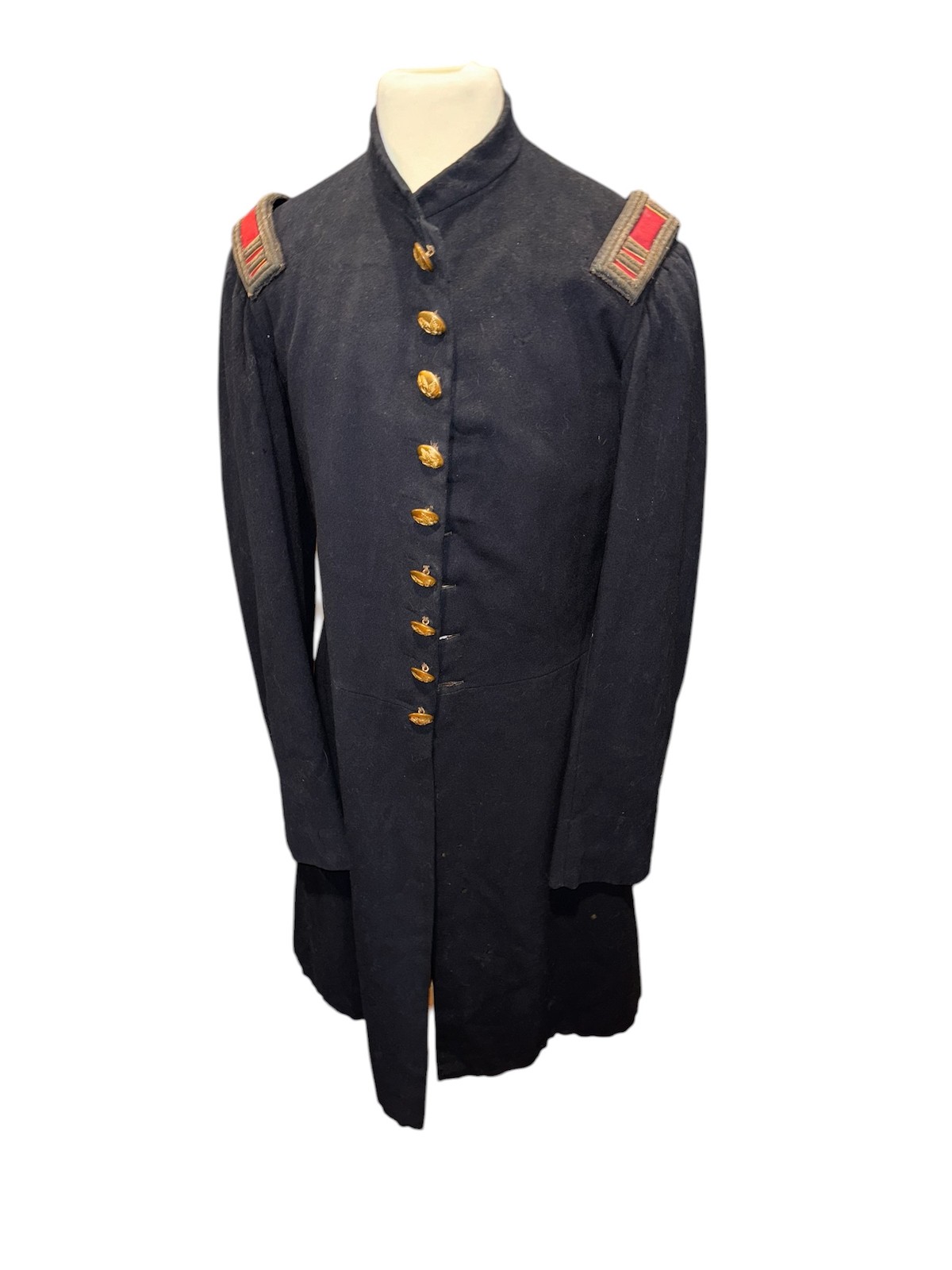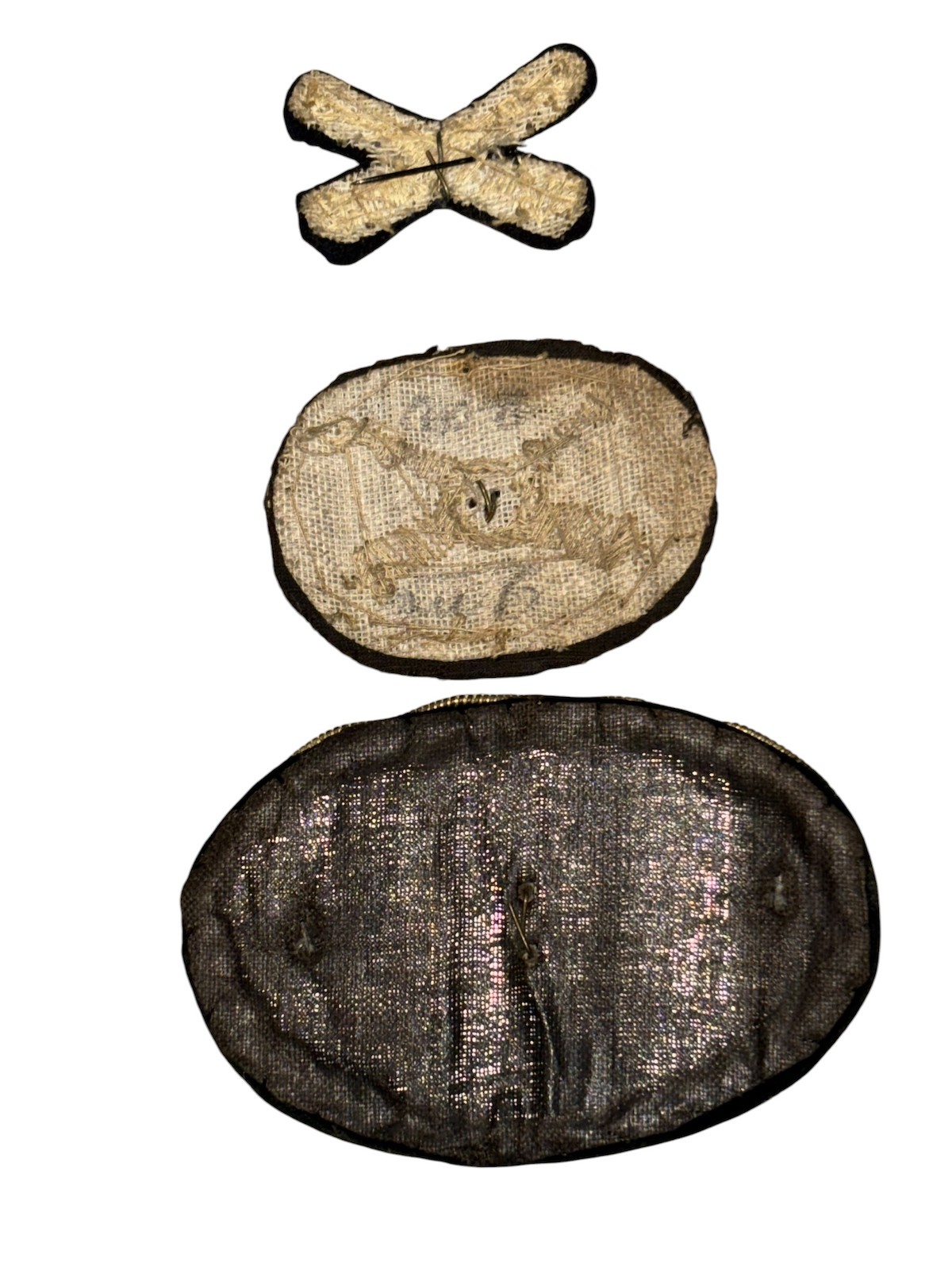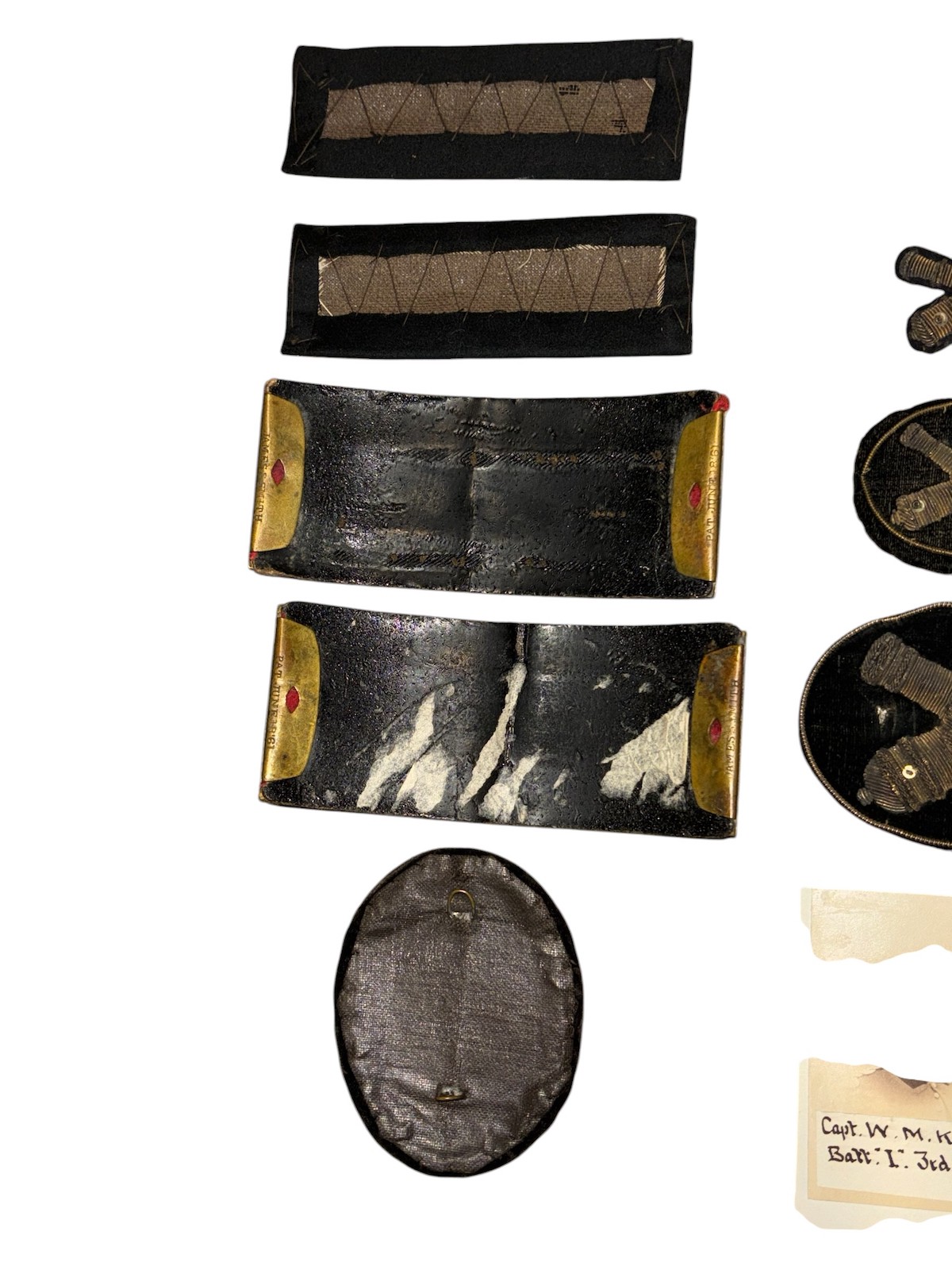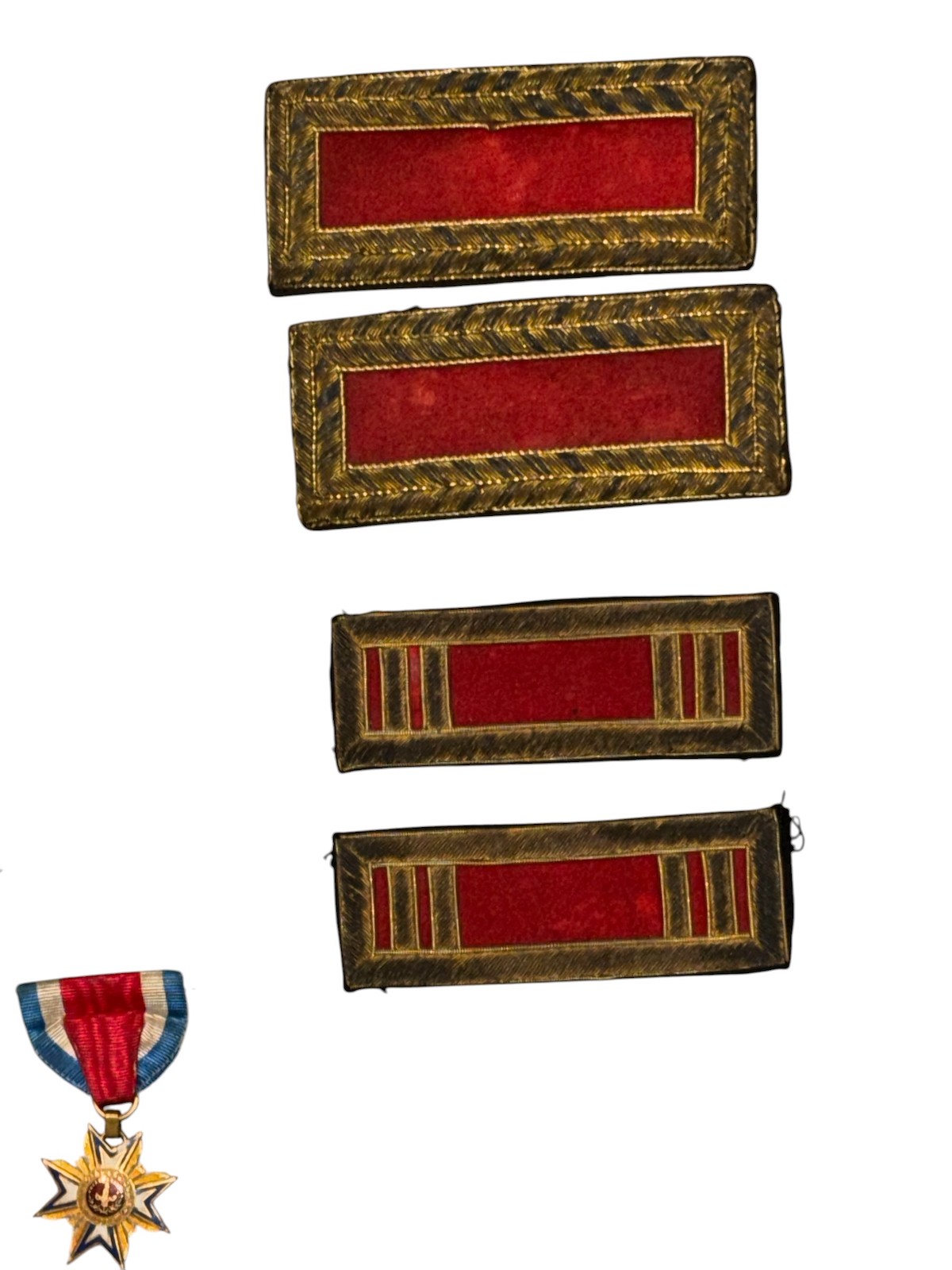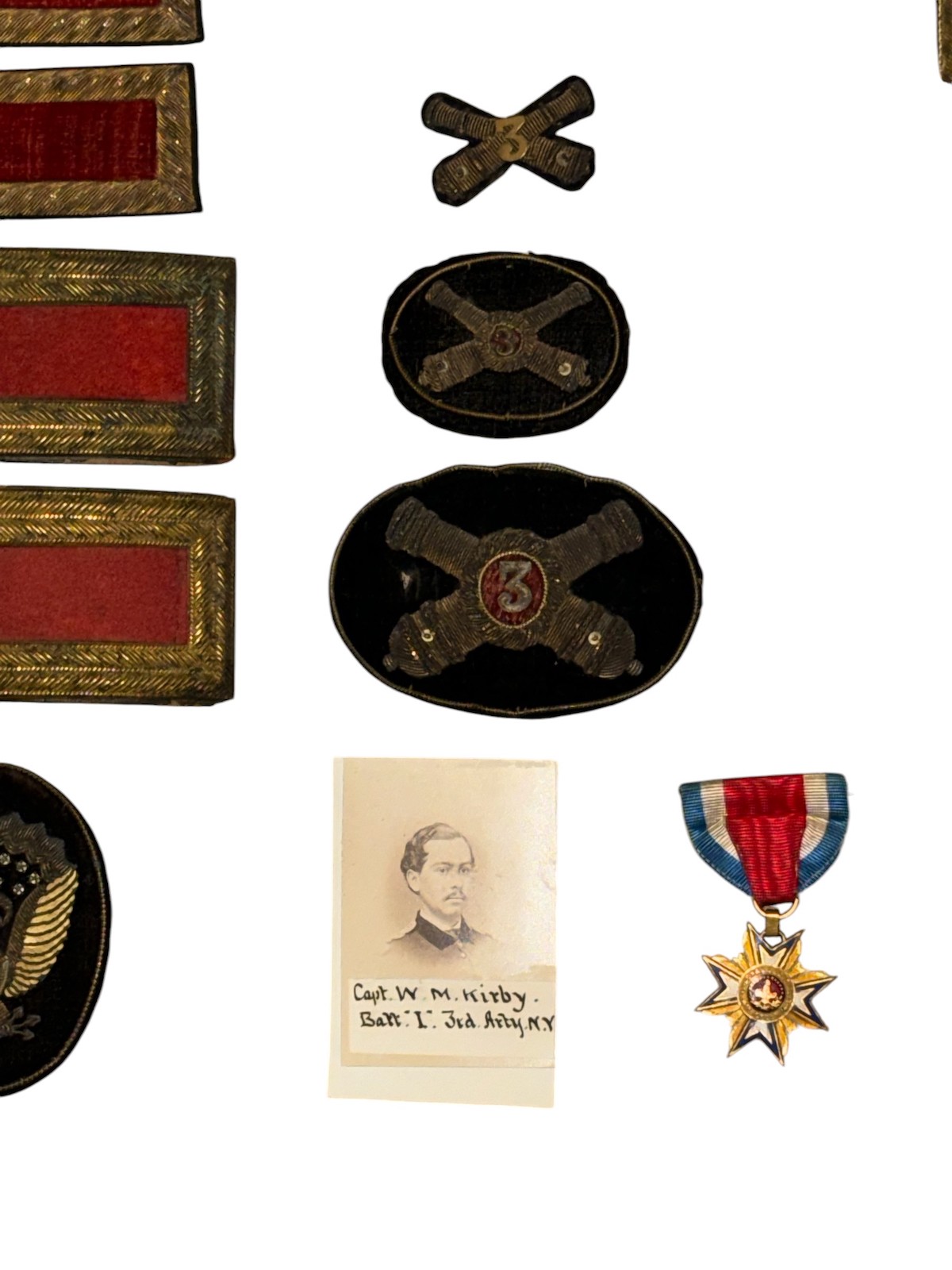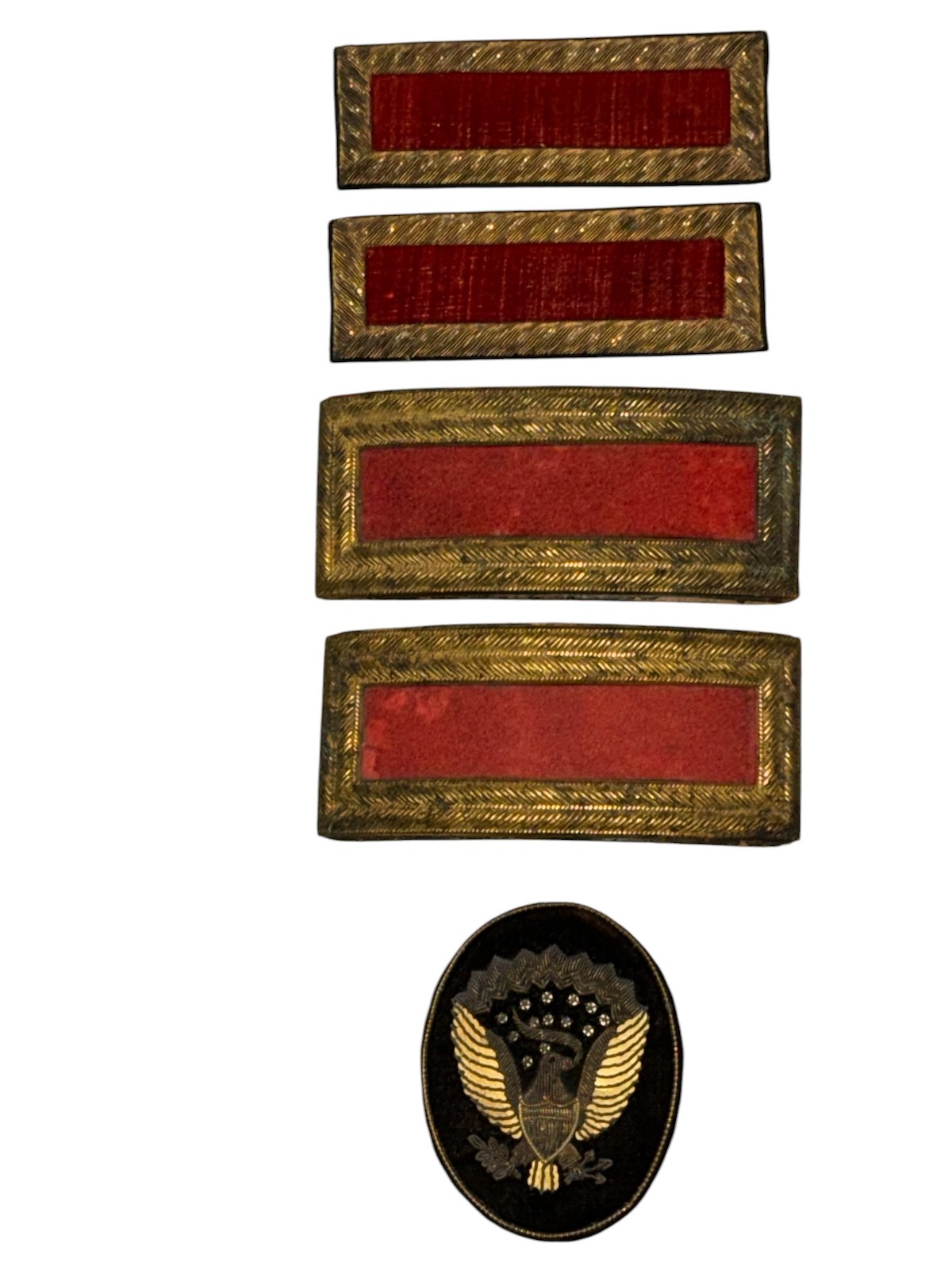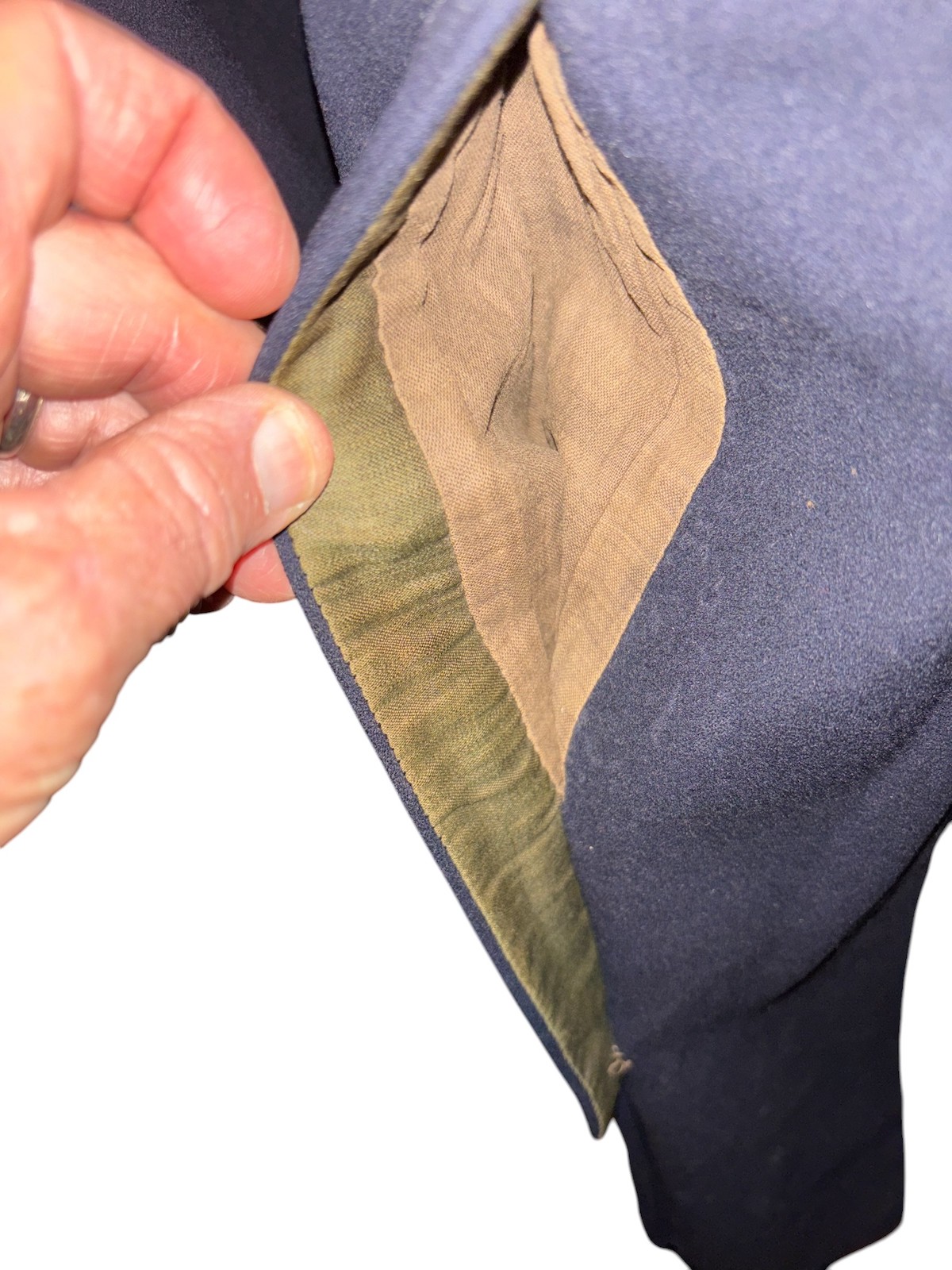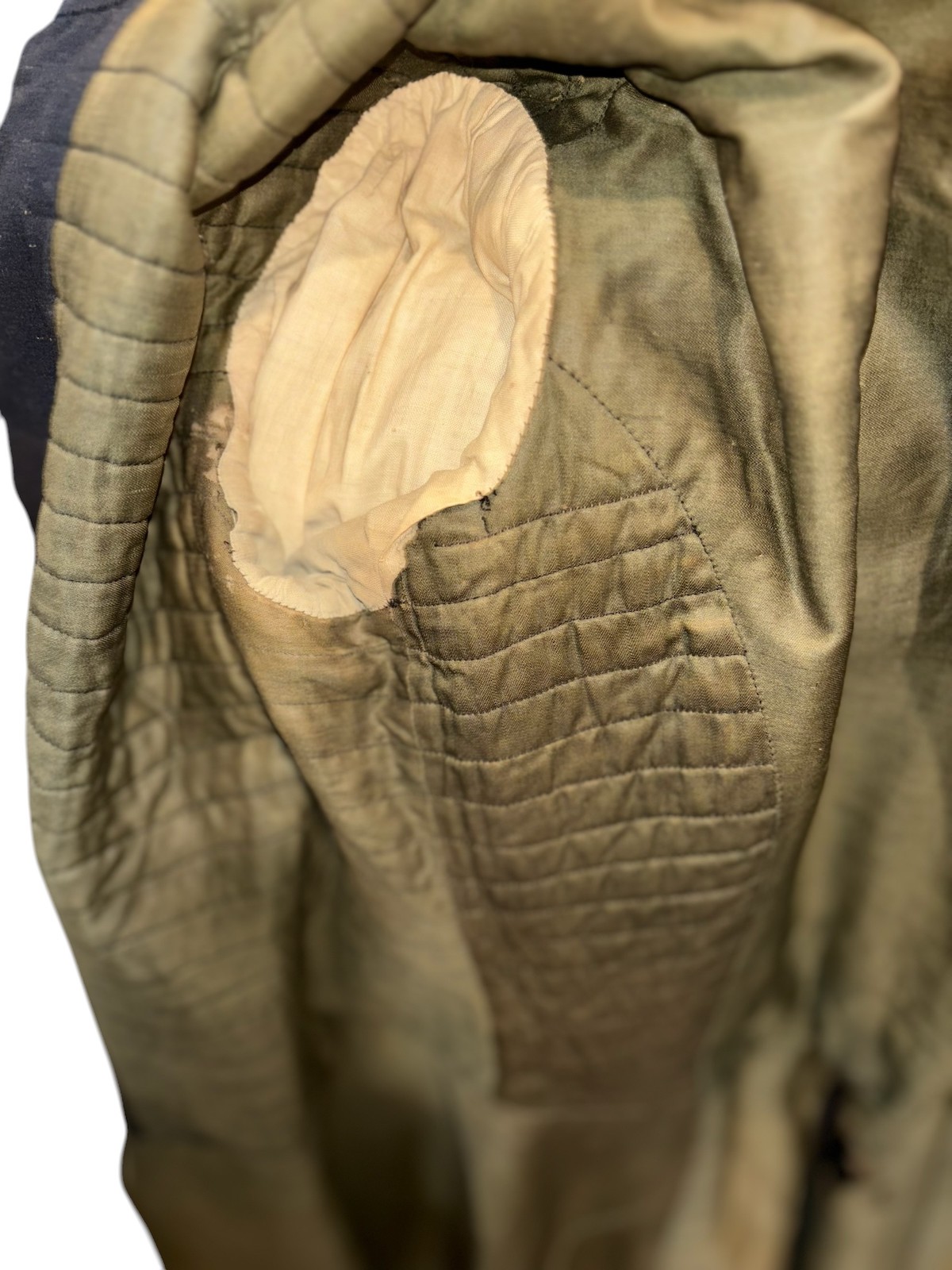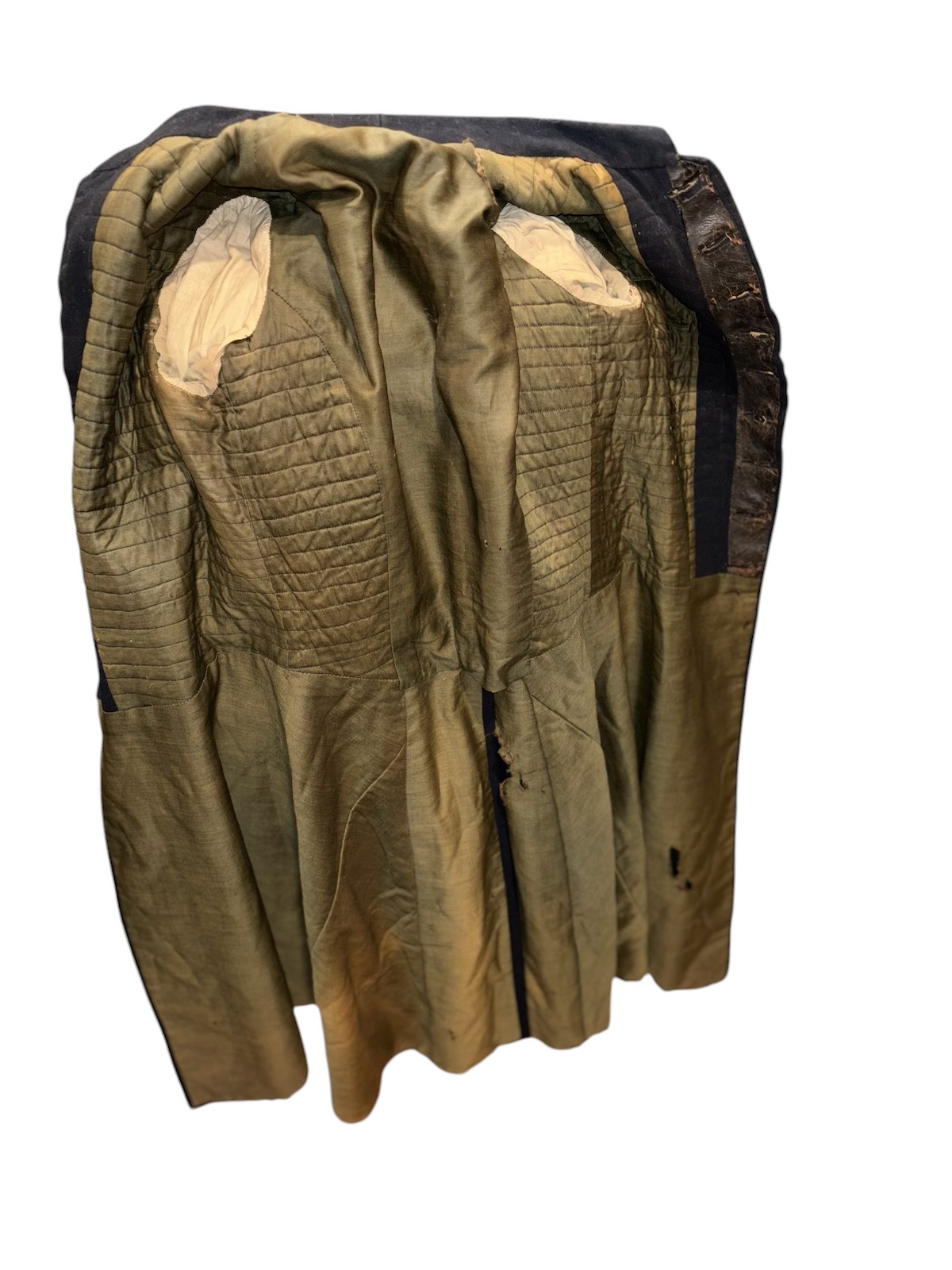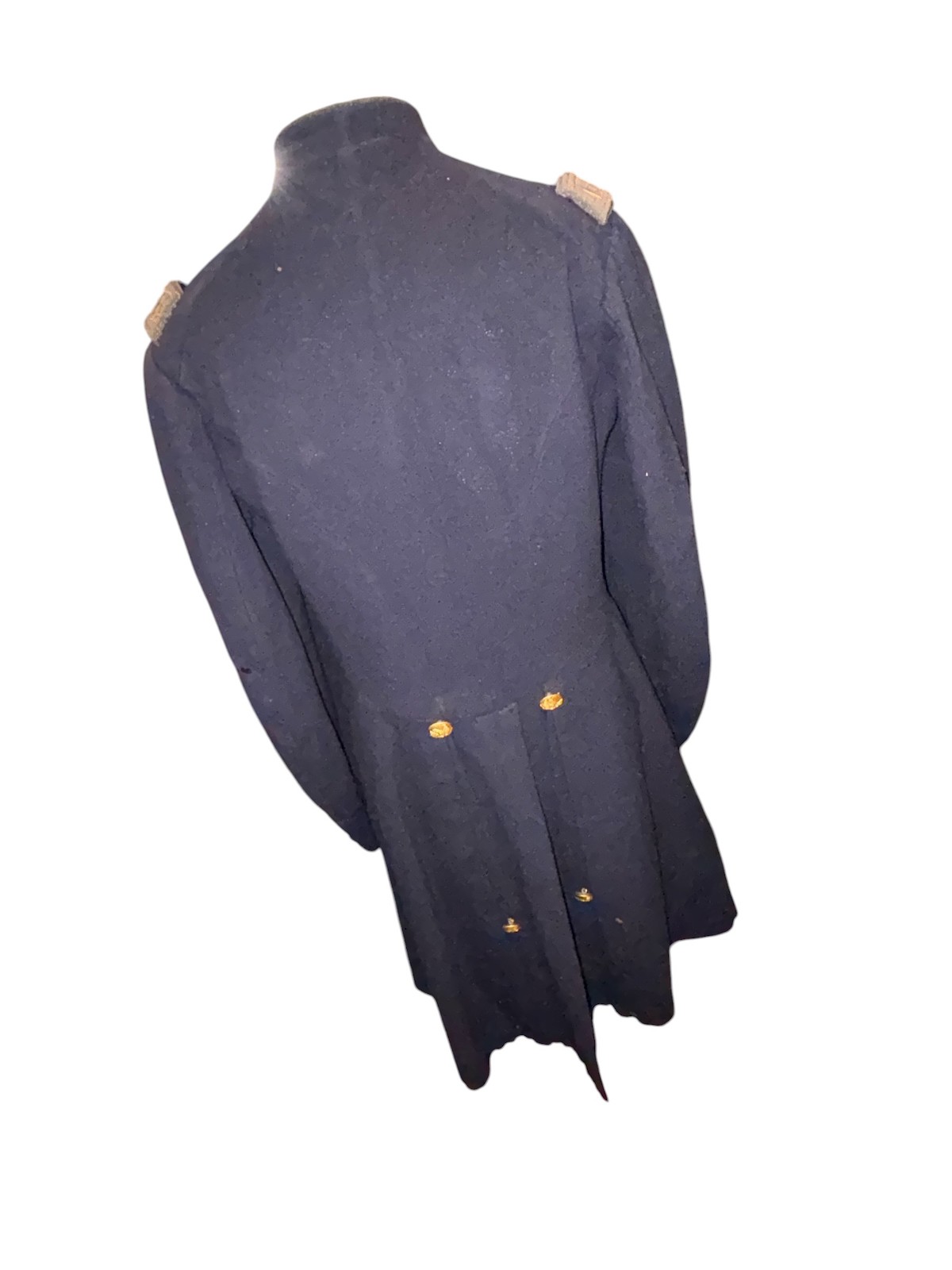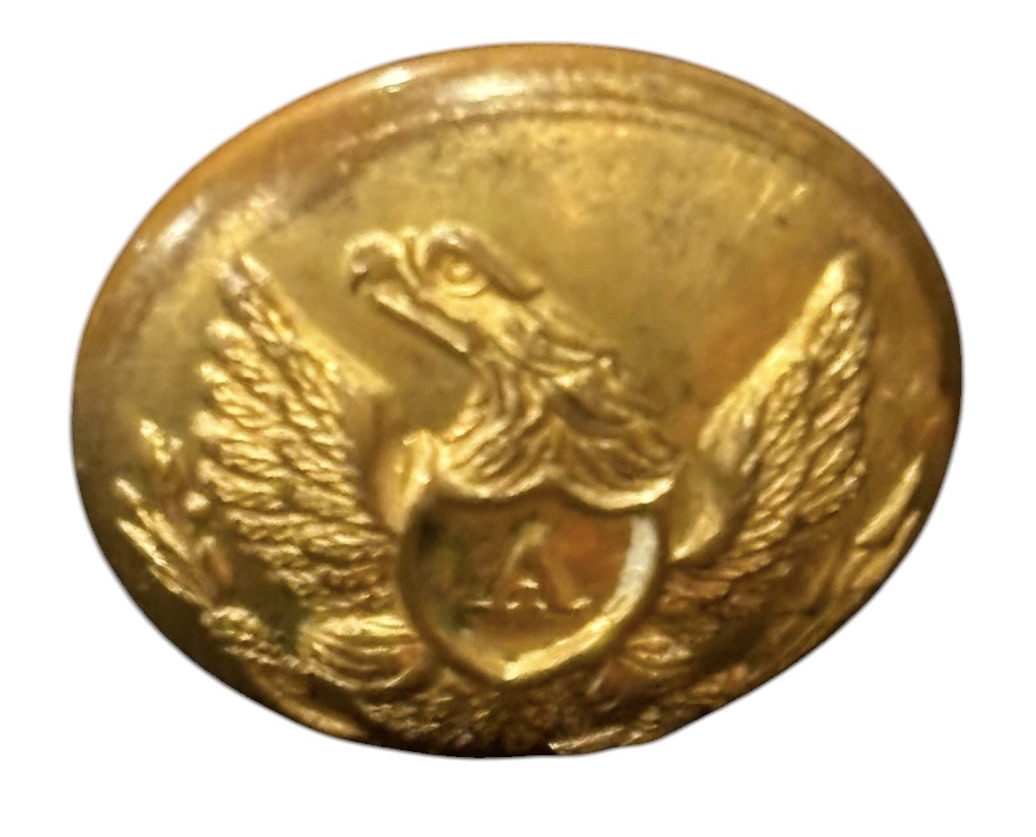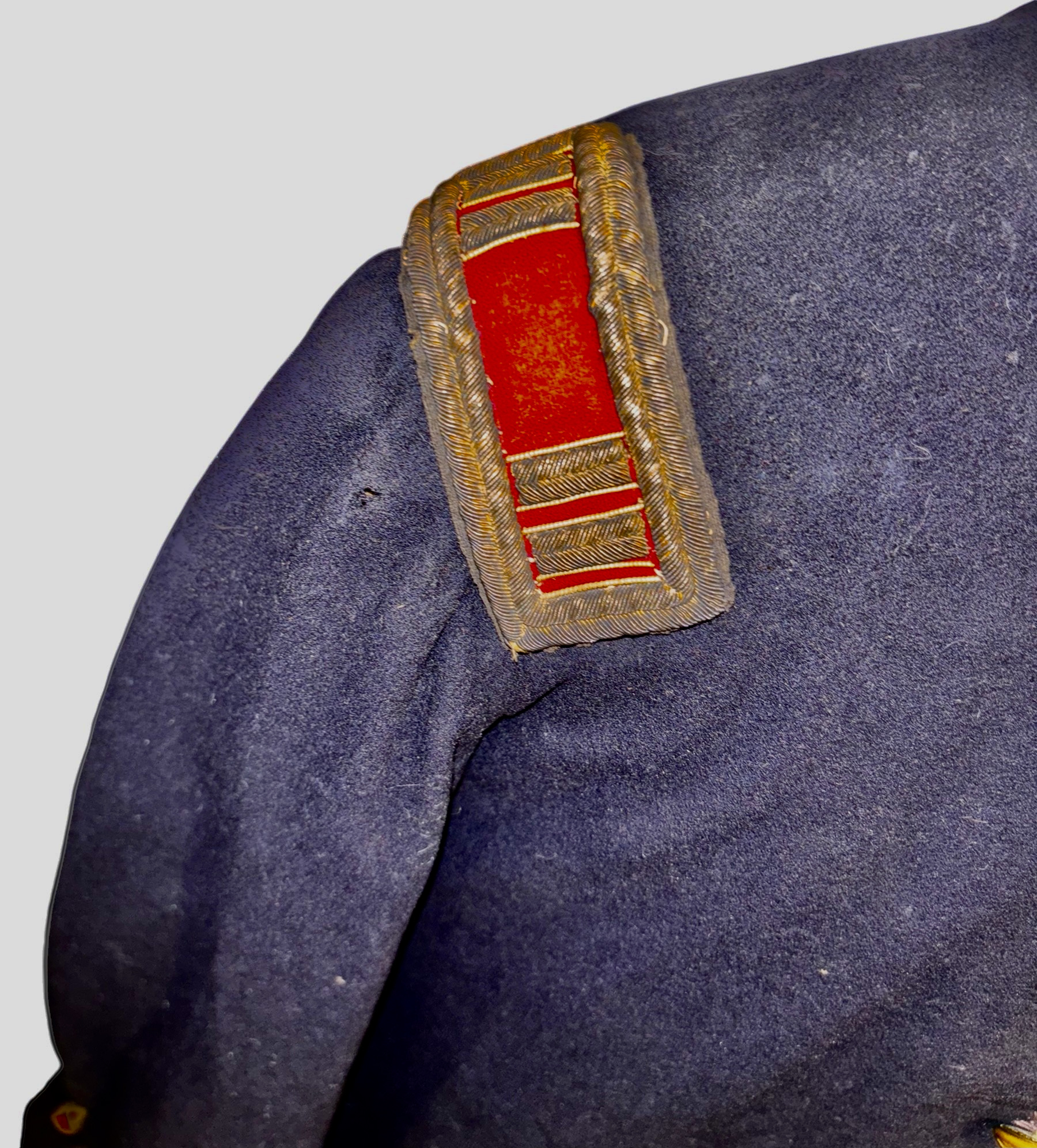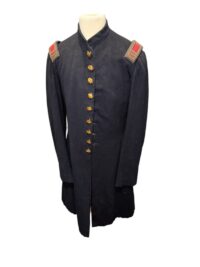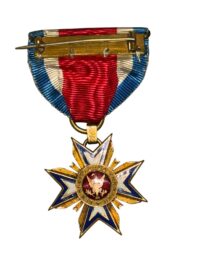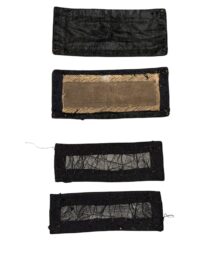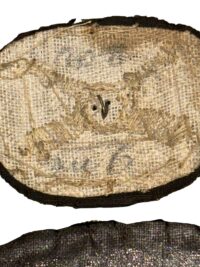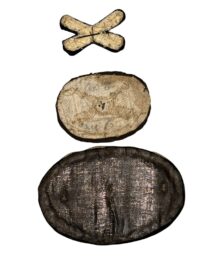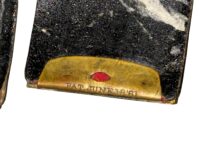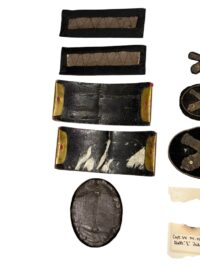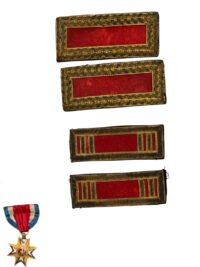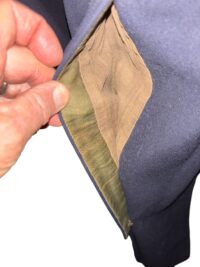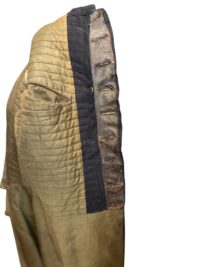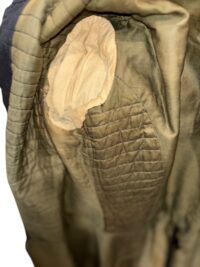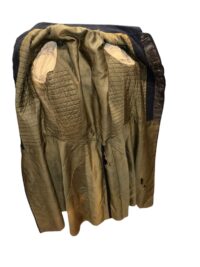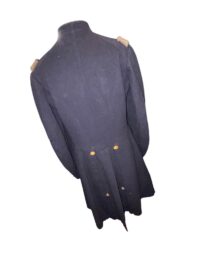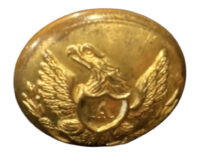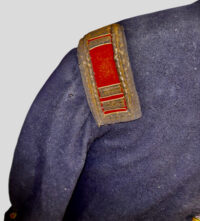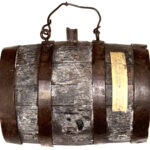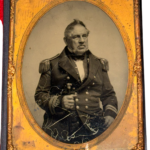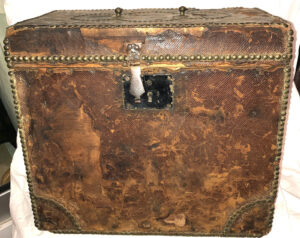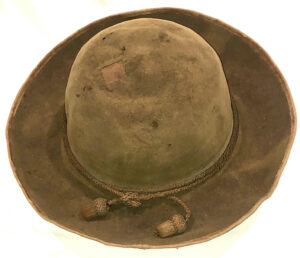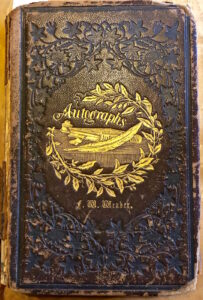Rank Straps, Insignia and Frock Coat of Captain William M. Kirby – Battery K 3rd New York Light Artillery
$9,850
Rank Straps, Insignia and Frock Coat of Captain William M. Kirby – Battery K 3rd New York Light Artillery – This impressive grouping has been an element of a significant collection for many years, prior to us obtaining it. All of the various aspects of the grouping were owned by Captain William M. Kirby of Battery K 3rd New York Artillery. Kirby enlisted at the age of 21, in January, 1862, at the rank of 2nd Lt.; two weeks later, he was commissioned, at that rank, in Battery K of the 3rd NY Light Artillery. He remained in the 3rd throughout his military service in the war, mustering out in Richmond, Va., in July, 1865. Kirby’s battery saw late war service in North Carolina, where Kirby was captured at Beech Grove, NC and sent to the Confederate prison facility, “Camp Sorghum”, near Columbia, SC; Kirby escaped from captivity in April, 1865 and returned to his battery. Included in the grouping are the following:
- Captain Kirby’s Artillery officer’s frock coat – all Eagle A coat buttons are present; 4 Eagle A cuff buttons are missing (we will supply the buyer with replacements); the coat is in overall very good condition, with some scattered, minor moth nips; the sleeve linings are constructed of an off-white linen; the body interior is lined in the typical, period, green, quilted satinet; the bottoms of the skirts are unhemmed; the elbows are in the “balloon” style; the shoulder areas are gathered where they are joined to the body of the coat; there are brown polished cotton lined pockets in the tails; the coat is constructed of a fine, English, broadcloth wool that is indigo-dyed, deep blue; both of Kirby’s original, double bullion, Artillery Captain’s rank boards remain in place.
- A signed, clipped, CDV of Captain Kirby
- A significant group of Captain Kirby’s insignia: large, bullion embroidered, officer’s Hardee hat badge; 3 embroidered Officer’s Slouch or Forage cap Artillery Insignia for the 3rd NY – one is large, one medium and one small in size
- 2 pairs of Artillery 2nd rank boards; one is single bullion with red velvet field; one is double bullion with red velvet field
- 1 pair of Artillery 2nd rank boards; double faux bullion; large size with red velvet fields; this pair are the early (patent dated 1861) rare, marked Smith’s Patent straps, with markings stamped into the brass clips that were to attach to brackets sewn to the wearer’s frock coat shoulders
- 1 single bullion, pair of rank straps for a Captain of the Artillery; red velvet fields
- Captain Kirby’s MOLLUS medal; numbered on the clasp 235
After the war, Captain Kirby became active in the hardware business of Hamlin, Kirby & Goodrich, in New York. In 1876, he became the adjutant of the New York National Guard 49th Reg. In 1881, Kirby took command of the “Wheeler Rifles” (predecessor of the New York 108th Inf. N.G.). By the time of the outbreak of the Spanish American War, he was a Lt. Col. in the 3rd Reg. of the NY National Guard.
William M. Kirby
| Residence was not listed; 21 years old.
Enlisted on 1/1/1862 at Auburn, NY as a 2nd Lieutenant. On 1/17/1862 he was commissioned into “Batty K” Co. NY 3rd Light Artillery He was Mustered Out on 7/8/1865 at Syracuse, NY He was listed as: * POW 2/2/1864 Beech Grove, NC (Confined at Columbia, SC) * Escaped 4/30/1865 Columbia, SC (Returned to battery) Promotions: * 1st Lieut 10/15/1863 * Capt 2/25/1865 (As of Battery I) Intra Regimental Company Transfers: * 2/25/1865 from company Batty K to company Batty I |
3rd LA Batty K NY Light Artillery Battery
( 3-years )
| Organized: Union Springs, NY on 12/11/61 Mustered Out: 6/30/65 at Richmond, VA |
| From | To | Brigade | Division | Corps | Army | Comment |
| Apr ’64 | May ’64 | Artillery | 1 | 18 | Army of the James | |
| Jun ’64 | Jun ’64 | Artillery | 3 | 18 | Army of the James | |
| Jun ’64 | Dec ’64 | Artillery | 18 | Army of the James | ||
| Dec ’64 | Jun ’65 | Artillery | 24 | Army of the James | Mustered Out |
BATTERY “K,” 3rd REGIMENT LIGHT ARTILLERY.
Organized at Auburn and mustered in December 20, 1861. Attached to Defences of Washington to March, 1862. Unattached, Department of North Carolina, to December, 1862. Artillery Brigade, Dept. of North Carolina, to January, 1863. Artillery Brigade, 18th Army Corps, Dept. of North Carolina, to May, 1863. Defences of Newberne, N. C., 18th Corps, to April, 1864. U. S. Forces, Yorktown, Va., Dept. of Virginia and North Carolina, April, 1864. Artillery, 1st Division, 18th Army Corps, Army of the James, to May, 1864. Artillery, 3rd Division, 18th Army Corps, to June, 1864. Artillery Brigade, 18th Army Corps, to December, 1864. Artillery Brigade, 24th Army Corps, to June, 1865.
Service:
Duty in the Defences of Washington, D. C., till March, 1862. Sailed for New Berne, N. C., March 27, arriving there April 2. Duty at New Berne till April, 1864. Expedition from New Berne to Tarboro November 1-12. Action at Rawle’s Mills November 2. Foster’s Expedition to Goldsboro December 11-20. Actions at Kinston December 14. Whitehall December 16. Goldsboro December 17. Expedition to Trenton July 4-8, 1863. Quaker Bridge July 6. Expedition to Swift Creek July 17-20. and to Winton July 25-31. About New Borne February 1-4, 1864. Moved to Yorktown, Va., April, 1864. Butler’s operations on south side of the James River and against Petersburg and Richmond May 4-28. Port Walthall May 6-7. Swift Creek May 9-10. Proctor’s Creek
Camp Sorghum – Confederate Prison Camp near Columbia, SC
Camp Sorghum
Camp Sorghum, Columbia, South Carolina.
Camp Sorghum was a Confederate States Army prisoner of war camp located in Columbia, South Carolina, during the American Civil War.
Established in late 1864 as a makeshift prison for approximately 1,400 Union officers, Camp Sorghum consisted of a 5-acre (20,000 m2) tract of open field, without walls, fences, buildings, or any other facilities. A “deadline” (boundary line) was established by laying wood planks 10 feet (3.0 m) inside the camp’s boundaries.
Rations consisted of cornmeal and sorghum syrup as the main staples in the diet; thus the camp became known as “Camp Sorghum”. Due to the lack of any security features, escapes were common. Conditions were terrible, with little food, clothing, or medicine, and disease claimed a number of lives among both the prisoners and their guards.[1]
The camp was the site of the imprisonment of S. H. M. Byers, as well as the location in which Byers created his two most famous works: the poem that lent its name to Sherman’s March to the Sea, and The Song of Iowa. During his imprisonment at Camp Sorghum, Byers read a newspaper that had been smuggled into camp by a slave in a piece of bread. From that he learned of Sherman’s March to the Sea, and the taking of Atlanta, Georgia. Byers wrote a poem about the March, which was set to music by fellow prisoner W. O. Rockwell. The song was smuggled out of the prison in the wooden leg of Lt. Daniel W. Tower, and became an immediate hit in the north.
The prisoners of Camp Sorghum were eventually transferred to the property of the state mental asylum in Columbia sometime before the city was captured in February 1865.[3] Most of the POWs were removed from Columbia on February 12, 1865, as William Tecumseh Sherman’s Union Army approached the city. Byers however managed to hide in the attic of the asylum, and became one of the first to greet the Union Army upon its entrance to Columbia.
Located on the Lexington side of the Saluda River, the prisoner of war camp received its name from the meager rations of molasses (sorghum) and cornmeal afforded its inmates. An estimated 1,400 Union soldiers were kept on the 5-acre plot. The prison site offered no shelter or latrines. Shelter at the prison proved equally Spartan with inmates seeking refuge from the elements in shallow holes covered with twigs, leaves, and pine boughs. At least 8 men died from disease and exposure. Escapes were frequent, with 373 inmates making their way to freedom by the time the camp was moved in December 1864.
New York
THIRD REGIMENT OF ARTILLERY (LIGHT; VETERAN).
Seward Artillery; Cayuga Regiment.
(Three Years)
| This regiment was accepted by the State for a service of
two years as a regiment of infantry, and designated the 19th Regiment, May 17, 1861. It was organized at Elmira, and there mustered in the service of the United States, by an error, for three months only. August 2, 1861, it was ordered, however, at the request of the War Department, by the Governor of the State, to be mustered in the service of the United States for the unexpired portion of its State service. The 49th Militia formed the nucleus of the regiment, and the men were recruited principally in the counties of Cayuga, Seneca and Wayne; the counties of Cattaraugus, Chenango, Cortland, Onondaga, Oswego, Madison, Tioga and Tompkins also furnished some of the men. The regiment left the State, under Col. John S. Clark, June 6, 1861. December 11, 1861, under Col. James H. Ledlie, it was converted into an artillery regiment. At the expiration of its term of service, those entitled to be discharged left the field, May 22, 1863, and were mustered out in the State; the regiment, however, was continued in the service, receiving new companies and recruits. It served as infantry at and near Washington, D. C., from June, 1861; in Sanford’s Division, Patterson’s Army, from July, 1861; in Butterfield’s Brigade, same command, from July 11, 1861; in the 1st Brigade, Bank’s Division, from July 29, 1861; in the 3d Brigade from September 25, 1861, and in Williams’ Brigade from December, 1861; as artillery in North and South Carolina, 18th and 10th Corps, and Batteries E, H, K and M in the Army of the James, from March, 1862. It was honorably discharged and mustered out, under Col. Charles H. Stewart, between June 23 and July 24, 1865, having lost by death during its service, killed in action, 1 officer, 13 enlisted men; of wounds received in action, 8 enlisted men; of disease and other causes, 4 officers, 283 enlisted men; total, 5 officers, 304 enlisted men; aggregate, 309; of whom 25 enlisted men died in the hands of the enemy. Battery A, originally organized at Auburn, was mustered in at Elmira, May 22, 1861, under Capt. John T. Baker. September 28, 1861, the enlisted men of Company F were transferred to it, and June 2, 1863, it was mustered out at Auburn, under Capt. Charles White, its three years’ men having been transferred to Companies E, I and K. It served as an artillery company at or near Washington, D. C., from December, 1861; in North Carolina, 18th Corps, from March, 1862; in South Carolina, 10th Corps, from January, 1863. A new Company A, recruited principally at Auburn, Moravia, Sennett, Venice, Cato, Mentz, Brutus, Ira, Lafayette, Elbridge, Rochester, Throup, Conquest, Owasco and Niles, was mustered in the United States service for one year September 23, 1864, under Capt. Samuel P. Russell. This company served in the 18th Corps and Department of Virginia, and from March 2 to April 17, 1865, in Carter’s Division, Provisional Corps, in North Carolina, and was mustered out at Syracuse, July 3, 1865. Battery B, originally organized at Auburn, was mustered in the United States service at Elmira, May 22, 1861, under Capt. Terrence J. Kennedy. September 28, 1861, it received by transfer some of the men of Company H, and February 22, 1862, it was consolidated with Companies C and E. A new company, under Capt. Joseph J. Morrison, recruited principally in New York city and Penn Yan, and mustered in the United States service for three years at New York city, December 19, 1861, took its place. This company was converted into a light battery in May, 1862, and served in the 18th Corps in North Carolina from March, 1862; in the Artillery Brigade, 18th Corps, from December, 1862, and in South Carolina, 10th Corps, from January, 1863. It was mustered out July 13, 1865, at Syracuse, under Capt. Thomas J. Mersereau. Battery C, originally organized at Seneca Falls, was mustered in the United States service at Elmira, May 22, 1861, under Capt. James E. Ashcroft. February 28, 1862, some of the enlisted men of Company B were transferred to it. May 22, 1863, its three years’ men were transferred to Companies I and K, and the company was mustered out under Lieut. Charles B. Randolph, at Elmira, June 2, 1863, having served as an artillery company in the 10th and 18th Corps in North and South Carolina. September 30, 1863, a new company, recruited principally at Utica, Syracuse, Rome, Sangerfield, Hamilton, Vernon, Annsville, Rochester, Bridgewater, Norwich, Albany and Deerfield, and mustered in the United States service for three years, August 31, 1863, commanded by Capt. W. E. Mercer, took its place. This company served in the 18th Corps, and Department of Virginia, in North Carolina; in Carter’s Division, Provisional Corps, from March, 1865; in the Reserve Artillery, 23d Corps, from April 5, 1865, and, under the command of Captain Mercer, was mustered out July 14, 1865, at Syracuse. Battery D, originally organized at Auburn, was mustered in the United States service May 22, 1861, under Capt. Owen Gavigan, and was formed principally of Irishmen. September 28, 1861, it received by transfer some of the enlisted men of Company K. Its three years’ men were transferred to Companies E, I and K, May 22, 1863, and the company was mustered out at Elmira, June 2, 1863. It served in North Carolina, in the 18th Corps, from March, 1862, and in South Carolina, in the 10th Corps, from January, 1863. In March, 1864, a new company, recruited principally at Syracuse, Auburn, Fayette, Locke, Skaneateles, Seneca Falls, Owasco and Onondaga, mustered in the United States service at Syracuse in February, 1864, for one, two and three years’ service, and commanded by Capt. Stephen Van Heusen, joined the regiment, replacing the mustered-out company. This company served in the 18th Corps, and Department of Virginia; in Carter’s Division, Provisional Corps, from March, 1865; in Reserve Artillery, 23d Corps, from April 5, 1865, in North Carolina; and was mustered out under Captain Van Heusen, at Syracuse, July 5, 1865. Battery E, originally organized at Auburn, mustered in the United States service May 22, 1861, at Elmira, under Capt. Theodore H. Schenck, received by transfer, February 28, 1862, some of the enlisted men of Company B, and May 22, 1863, some of the three years’ men of Companies A, C and D. At the expiration of its term of service, those entitled to be discharged were sent to Elmira and there mustered out, and the battery itself retained in service. It was converted into a light battery in August, 1862; served in North Carolina from March, 1862; in the Artillery Brigade, 18th Corps, from December, 1862; in South Carolina, in the 10th Corps, from January, 1863; in North Carolina, in the 18th Corps, from May, 1863; at Yorktown, Va., from April, 1864; in the Artillery, 2d Division, 18th Corps, Army of the James, from May, 1864; in the Artillery Brigade, 18th Corps, from June, 1864; with the 10th Corps from August, 1864; with the 18th Corps from September, 1864; and in the Artillery Brigade, 24th Corps, from December, 1864. It was, commanded by Capt. George E. Ashby, mustered out at Richmond, Va., June 23, 1865. Battery F, originally organized at Moravia, mustered in the United States service May 22, 1861, at Elmira, under Capt. Nelson T. Stephens, was transferred to Company A September 28, 1861. February 22, 1862, a new company, original 10th Battery, commanded by Capt. Edwin S. Jenney, took its place. This company, recruited and organized at Syracuse, and there mustered in the service of the United States for three years December 18, 1861, was converted into a light battery in May, 1862. At the expiration of its term of service those entitled thereto were discharged and the battery retained in the service. It served in North Carolina from March, 1862; in the Artillery Brigade, 18th Corps, from December, 1862; in the 10th Corps and South Carolina from January, 1863; in the District of Florida from September, 1864; and was mustered out, commanded by First Lieut. Edgar H. Titus, July 24, 1865, at Syracuse. Battery G, originally organized at Auburn, mustered in the United States service under Capt. Chas. H. Stewart, May 22, 1861, at Elmira, received, September 28, 1861, by transfer some of the men of Company K. Its three years’ men were transferred to new Company K, May 22, 1863, and the battery mustered out at Elmira, June 2, 1863, having served in North Carolina in the 18th Corps, from March, 1862. A new company took its place in March, 1864, which, commanded by Capt. David L. Aberdeen, was mustered in the Unite States service for three years, and recruited principally at Syracuse, Auburn, Waterloo, Sharon, Skaneateles, Brutus, Seneca Falls, Elbridge, Onondaga and Cicero. It served in the 18th Corps, and Department of Virginia; in the Provisional Corps in North Carolina from March, 1865; in Artillery Reserve, 23d Corps, from April 5, 1865, and was mustered out under Capt. William A. Kelsey, July 7, 1865, at Syracuse. Battery H, organized at Weedsport, mustered in the United States service at Elmira, May 22, 1861, under Capt. Solomon Giles, was transferred to Companies B and I September, 28, 1861. A new company, commanded by Capt. William J. Riggs, took its place February 22, 1862. This company, formed of organizations recruited by Captains Clark, Mercer and Tryon, at Rome, for H. R. White’s regiment, and there mustered in the United States service for three years, and in which the Grinnell Light Artillery was merged, was converted into a light battery in May, 1862. At the expiration of its term of service those entitled thereto were discharged and the battery continued in service. It served in North Carolina from March, 1862; in the Artillery Brigade, 18th Corps, from December, 1862; at and near Fort Monroe, Va., from October, 1863; at Newport News, Va., from December, 1863; in the defenses of Portsmouth, Va., from April, 1864; in the Artillery Brigade, 18th Corps, from June, 1864, and in the 24th Corps from December, 1864. It was mustered out, commanded by Capt. Enoch Jones, June 24, 1865, at Richmond, Va. Battery I, originally organized at Auburn, was mustered in the service of the United States, May 22, 1861, at Elmira, commanded by Capt. John H. Ammon. Some of the enlisted men of Companies H and K were transferred to it, September 28, 1861. May 22, 1863, it received some of the three years’ men of Companies A, C and D, and its two years’ men were forwarded to Elmira, where they were discharged June 2, 1863, while the battery was continued in service. It served in North Carolina from March, 1862; in the Artillery Brigade, 18th Corps, from December, 1862; in South Carolina, 10th Corps, from January, 1863, and in the 18th Corps, and Department of Virginia, from May, 1863; in Carter’s Division, Provisional Corps, in North Carolina, from March, 1865; in Artillery Reserve, 23d Corps, from April 5, 1865. It was mustered out, under Capt. William M. Kirby, at Syracuse, July 8, 1865. Battery K, originally organized at Union Springs, was mustered in the United States service May 22, 1861, at Elmira, under Capt. James R. Angel, and transferred to Companies D and G and a few of the men to Company I, September 28, 1861. A new company, commanded by Captain Angel, recruited principally at Auburn and Union Springs, and mustered in the United States service for three years, took its place December 20, 1861. This company was, in June, 1862, converted into a light battery. May 22, 1863, it received a number of three years’ men of Batteries D and G, and at the expiration of its term of service those entitled thereto were discharged and the battery continued in service. It served in North Carolina from March, 1862; in the Artillery Brigade, 18th Corps, from December, 1862; in the 1st Division, 18th Corps, Army of the James, from April, 1864; in the 3d (Hink’s) Division, 18th Corps, from May, 1864; in the Artillery Brigade of the 18th Corps, from June, 1864; and in the Artillery Brigade of the 24th Corps, from December, 1864. Commanded by Captain Angel, it was mustered out June 30, 1865, at Richmond, Va. Battery L. Capt. Terrence J. Kennedy of Company B was ordered to recruit this battery, but received from the State authority to organize it as an independent battery (the 1st). For some reason this battery was reported by the regimental commander as Battery L of this regiment; it never joined the regiment, and was finally dropped from its returns. In March, 1865, the 24th Battery was transferred to the regiment as its Battery L, and so reported from May 28, 1865. This battery was mustered out, under Capt. Lewis H. Mowers, July 7, 1865, at Syracuse. Its losses are, however, not credited to the regiment, but to its independent organization. Battery M, Capt. James V. White. This company was originally organized for the 76th Infantry, as Company I. January 24, 1862, it was transferred to the 3d Artillery, and completed by consolidating with it Captain Hanson’s and another company, recruited for the Cherry Valley Regiment. It was recruited principally at Albany, Schenectady, Broadalbin, Elmira, Cherry Valley, Bainbridge, Newfield, Ithaca, Milford, Unadilla, Braman’s Cove, Sanford, Hartwick and Cayuta; organized at Albany and there mustered in the service of the United States for three years, January 18, 1862. At the expiration of its term of service those entitled thereto were discharged and the battery continued in service. It joined the regiment February 22, 1862, and served in North Carolina, and the 18th Corps, from March, 1862; at and near Fort Monroe, Va., from October, 1863; in Heckman’s Division, 18th Corps, from January, 1864; in the 1st Division, 18th Corps, from March, 1864; in the 3d Division, 18th Corps, Army of the James, from May, 1864; in the Artillery Brigade, 18th Corps, from June, 1864, and in that of the 24th Corps from December, 1864. Commanded by Capt. John H. Howell, it was mustered out at Richmond, Va., June 26, 1865. |
Gen William M. Kirby Veteran
Birth
2 Dec 1842
Death
2 Jan 1933 (aged 90)
Burial
Auburn, Cayuga County, New York, USA
William M. Kirby died January 2, 1933, age 90 years. Born in Springport Dec. 2, 1842. He was the son of William A. Kirby, inventor of the Kirby reaper.
Brig. Gen. William M. Kirby- retired Military officer, res. 72 years at 180 Genesee St. At the time of his death, oldest living past Commander Knights Templar.
Jan. 1, 1862 commissioned Lieut. Third N.Y. Artillery, promoted to Captain. for some time before the close of the war he was imprisoned at Libby from which he escaped.
In 1870s he was in the hardware business with Hamlin, Kirby & Goodrich.
In 1876 he was adjutant 49th Reg. 1881 took command wheeler rifles (predecessor 108th Inf. N.G.)
At the outbreak of the Spanish American War he was a lieu. Col. 3rd Reg.
At the time of his death he was survived by daughters; Mrs. Louis Jenkins, Auburn- Mrs. Robert Dixon, Port Byron- Mrs. George Wittmer, Auburn.
Military Service- Age: 22 years
Transferred- Age: 22 years
Date
Feb 25, 1865
Place
New York
Info
From Company: Batty K
Military Service- Ages: 23 – 21 years
Gold Star
Officer
Yes
Prisoner of War
Yes
Wounded
No
Imprisonment- Age: 21 years
Date
Feb 2, 1864
Place
Beech Grove, North Carolina
Info
Confined at Columbia, SC
Promoted- Ages: 22 – 21 years
Date
Oct 15, 1863
Rank
First Lieutenant
Date
Feb 25, 1865
Info
As of Battery I
Rank
Captain
Discharge- Age: 23 years
Date
Jul 8, 1865
Place
Syracuse, New York
Captain
Death– Jan 2, 1933-Age: 90 years
Burial
Auburn, Cayuga County, New York
Plot
Fort Hill Cemetery

